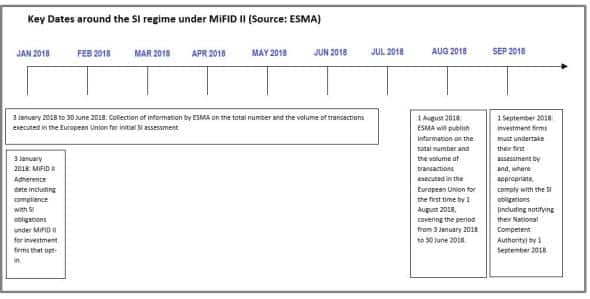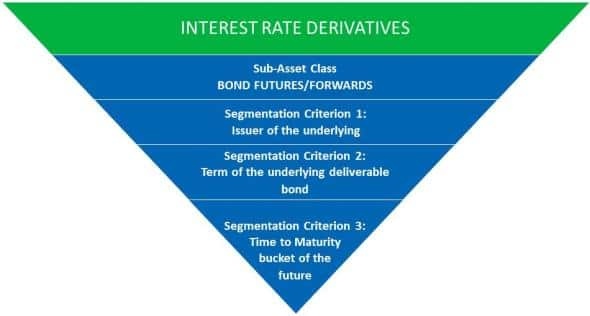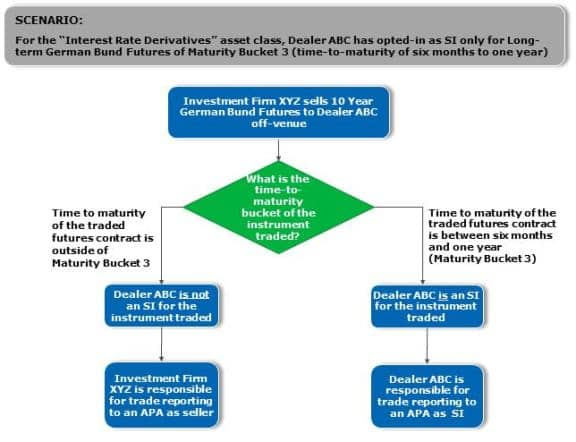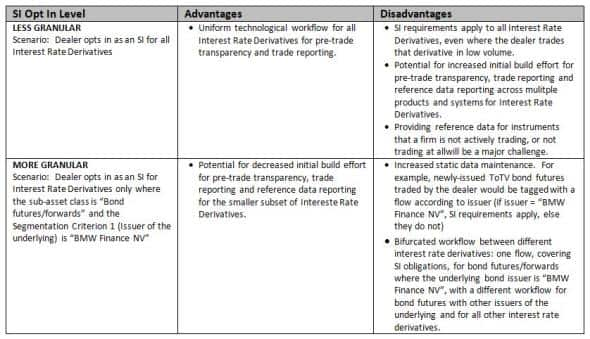Customer Logins
Obtain the data you need to make the most informed decisions by accessing our extensive portfolio of information, analytics, and expertise. Sign in to the product or service center of your choice.
Customer Logins
BLOG
Aug 24, 2017
To opt in or not to opt in? Dealers and Systematic Internaliser rules.
When ESMA announced in late 2016 that the quantitative threshold assessment under the MIFID II Systematic Internaliser (SI) regime would commence from 1st September 2018, rather than 3rd January 2018, many in the dealer community breathed a sigh of relief. This was understandable as it bought time for those dealers likely to be assessed as SIs, based on the nature and magnitude of their trading activity, to build in-house systems or conduct vendor integration in preparation for that SI assessment. Those systems would be used to determine whether a dealer's trading activity crossed specific quantitative thresholds, slated for 1st August 2018 publication by ESMA, that would classify them as a Systematic Internaliser for given asset and sub-asset classes.
Exhibit A

However, as the adherence dates draw close, firms are realising that while not required to become an SI until 1st September 2018, if assessed as one, they may opt to become one early - as allowed under the MiFID II SI regime - in order to provide a high level of client service and to capture operational efficiencies.
Pros and Cons of Opting In as an SI
If being an SI subjects a dealer to new regulatory-driven requirements, what factors would drive a dealer to voluntarily take on these obligations ahead of regulatory assessment?
First, client demand is a factor. When a buyside acts as seller to a dealer that is not an SI for the instrument in a given transaction, the buyside is on the hook for real-time trade reporting to the public. Demand from larger buysides for their dealers to cover real-time trade reporting, along with competitor dealers' decisions to opt into the SI regime, will factor into a dealer's own decision to opt in or not. If a dealer knows that it will likely be assessed as an SI as of 1st September 2018, it might be a good strategy for client relations to opt in early, if only to remove the temporary trade reporting responsibility from clients on transactions between 3rd January 2018 and 1st September 2018.
The current volume of trading activity will also come into play. If a dealer is already actively trading on their own account in a given asset class(es) or sub-asset class(es), and is aware that they are likely to be assessed as an SI for specific products after 1st September 2018, opting in early and putting in requisite trade reporting workflows in time for 3rd January 2018 makes sense, rather than implementing one workflow for trade reporting and then changing it after the first SI assessment takes place.
However, these advantages of opting in early must be weighed against the compliance challenges faced by SIs. MiFID II requires SIs to offer pre-trade transparency in the form of published firm quotes for all liquid instruments for which the dealer is an SI. MiFID II also requires SIs to report reference data to their National Competent Authority (NCA) by 6pm CET each evening for every instrument for which they are an SI. The magnitude of these challenges depends on the dealer's approach to determining SI status. As the scope of instruments for which a dealer is an SI grows, the burden of transparency and reporting increases with it.
Focus on Granularity
Under RTS 2, ESMA has established multiple product levels at which an investment firm may opt in as an SI - the same granularity levels for which SI assessment will take place starting in the 3rd quarter of 2018. The level of granularity with an SI opt in election is another choice in a dealer's hands.
Exhibit B: Granularity for the SI Regime as applied to Bond Futures/Forwards

Consider the example highlighted in Exhibit B. Ahead of the initial 1st September 2018 SI assessment, taking place quarterly thereafter, a dealer may opt in as an SI for all Interest Rate Derivatives, or for a subset, such as all Bond Futures/Forwards (but not other Interest Rate Derivatives) or for all Bond Futures/Forwards from specific issuers. In fact, a dealer can choose to be even more granular: they may opt in as SI for only Bond Futures/Forwards for a specific bond issuer with a specific term of the underlying bond and of a specific time to maturity bucket for the futures contract.
While opting in at such a deep level of granularity may limit the instances for which a dealer is subject to SI regulatory obligations, there is a downside. As illustrated in Chart 1, a bifurcated workflow may prove confusing and inconvenient to clients, as well as add complexity to a dealer's own downstream system workflows. Chart 2 highlights the advantages and disadvantages of opting in at higher levels versus more granular levels.
Chart 1: SI workflow for granular application of SI

Chart 2: Implications of SI opt in strategy

The decision of whether to opt into the SI regime is a path riddled with pros and cons for dealers. Deciding the appropriate level of granularity requires much consideration. Dealers would do well to review their options early and make an early decision on the opt in process, leaving time to test and implement for SI-mandated workflows, including real time reporting to APAs, pre-trade transparency and reference data reporting from 3rd January 2018 (or any time thereafter if they opt in as an SI after that date). Dealers also need to think about how they will communicate their granular SI status to potentially thousands of clients. Hub and spoke systems such as Counterparty Manager from IHS Markit are among the solutions custom designed to help with this important last mile of work required by MiFID II.
Kirston Winters, David Cook and Harsh Agarwal are contributing authors on this piece.
S&P Global provides industry-leading data, software and technology platforms and managed services to tackle some of the most difficult challenges in financial markets. We help our customers better understand complicated markets, reduce risk, operate more efficiently and comply with financial regulation.
This article was published by S&P Global Market Intelligence and not by S&P Global Ratings, which is a separately managed division of S&P Global.
{"items" : [
{"name":"share","enabled":true,"desc":"<strong>Share</strong>","mobdesc":"Share","options":[ {"name":"facebook","url":"https://www.facebook.com/sharer.php?u=http%3a%2f%2fstage.www.spglobal.com%2fmarketintelligence%2fen%2fmi%2fresearch-analysis%2fto-opt-in-or-not-to-opt-in-dealers-and-systematic-internaliser-rules.html","enabled":true},{"name":"twitter","url":"https://twitter.com/intent/tweet?url=http%3a%2f%2fstage.www.spglobal.com%2fmarketintelligence%2fen%2fmi%2fresearch-analysis%2fto-opt-in-or-not-to-opt-in-dealers-and-systematic-internaliser-rules.html&text=To+opt+in+or+not+to+opt+in%3f+Dealers+and+Systematic+Internaliser+rules.","enabled":true},{"name":"linkedin","url":"https://www.linkedin.com/sharing/share-offsite/?url=http%3a%2f%2fstage.www.spglobal.com%2fmarketintelligence%2fen%2fmi%2fresearch-analysis%2fto-opt-in-or-not-to-opt-in-dealers-and-systematic-internaliser-rules.html","enabled":true},{"name":"email","url":"?subject=To opt in or not to opt in? Dealers and Systematic Internaliser rules.&body=http%3a%2f%2fstage.www.spglobal.com%2fmarketintelligence%2fen%2fmi%2fresearch-analysis%2fto-opt-in-or-not-to-opt-in-dealers-and-systematic-internaliser-rules.html","enabled":true},{"name":"whatsapp","url":"https://api.whatsapp.com/send?text=To+opt+in+or+not+to+opt+in%3f+Dealers+and+Systematic+Internaliser+rules. http%3a%2f%2fstage.www.spglobal.com%2fmarketintelligence%2fen%2fmi%2fresearch-analysis%2fto-opt-in-or-not-to-opt-in-dealers-and-systematic-internaliser-rules.html","enabled":true}]}, {"name":"rtt","enabled":true,"mobdesc":"Top"}
]}




